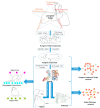A Novel Discovery: Holistic Efficacy at the Special Organ Level of Pungent Flavored Compounds from Pungent Traditional Chinese Medicine
- PMID: 30754631
- PMCID: PMC6387020
- DOI: 10.3390/ijms20030752
A Novel Discovery: Holistic Efficacy at the Special Organ Level of Pungent Flavored Compounds from Pungent Traditional Chinese Medicine
Abstract
Pungent traditional Chinese medicines (TCMs) play a vital role in the clinical treatment of hepatobiliary disease, gastrointestinal diseases, cardiovascular diseases, diabetes, skin diseases and so on. Pungent TCMs have a vastness of pungent flavored (with pungent taste or smell) compounds. To elucidate the molecular mechanism of pungent flavored compounds in treating cardiovascular diseases (CVDs) and liver diseases, five pungent TCMs with the action of blood-activating and stasis-resolving (BASR) were selected. Here, an integrated systems pharmacology approach is presented for illustrating the molecular correlations between pungent flavored compounds and their holistic efficacy at the special organ level. First, we identified target proteins that are associated with pungent flavored compounds and found that these targets were functionally related to CVDs and liver diseases. Then, based on the phenotype that directly links human genes to the body parts they affect, we clustered target modules associated with pungent flavored compounds into liver and heart organs. We applied systems-based analysis to introduce a pungent flavored compound-target-pathway-organ network that clarifies mechanisms of pungent substances treating cardiovascular diseases and liver diseases by acting on the heart/liver organ. The systems pharmacology also suggests a novel systematic strategy for rational drug development from pungent TCMs in treating cardiovascular disease and associated liver diseases.
Keywords: TCM; blood-activating and stasis-resolving; cardiovascular disease; liver disease; organ location; pungent flavored compound; systems pharmacology.
Conflict of interest statement
The authors declare no conflict of interest.
Figures





 : molecular interaction or relation (inhibition).
: molecular interaction or relation (inhibition).  : Phosphorylation,
: Phosphorylation,  : dephosphorylation.
: dephosphorylation.
 : molecular interaction or relation (inhibition).
: molecular interaction or relation (inhibition).  : Phosphorylation,
: Phosphorylation,  : dephosphorylation.
: dephosphorylation.

Similar articles
-
Systems Pharmacology Dissection of the Integrated Treatment for Cardiovascular and Gastrointestinal Disorders by Traditional Chinese Medicine.Sci Rep. 2016 Sep 6;6:32400. doi: 10.1038/srep32400. Sci Rep. 2016. PMID: 27597117 Free PMC article.
-
[Analysis on anti-hepatoma effect of medicine invigorating blood circulation and eliminating blood stasis based on warm-pungent-liver efficiency network].Zhongguo Zhong Yao Za Zhi. 2014 Jul;39(13):2417-21. Zhongguo Zhong Yao Za Zhi. 2014. PMID: 25276956 Chinese.
-
[Study on relations between transient receptor potential vanilloid 1 and pungent property of traditional Chinese medicines].Zhongguo Zhong Yao Za Zhi. 2014 Jul;39(13):2422-7. Zhongguo Zhong Yao Za Zhi. 2014. PMID: 25276957 Chinese.
-
The linkage of gut microbiota and the property theory of traditional Chinese medicine (TCM): Cold-natured and sweet-flavored TCMs as an example.J Ethnopharmacol. 2023 Apr 24;306:116167. doi: 10.1016/j.jep.2023.116167. Epub 2023 Jan 11. J Ethnopharmacol. 2023. PMID: 36641107 Review.
-
Traditional Chinese medicine network pharmacology: theory, methodology and application.Chin J Nat Med. 2013 Mar;11(2):110-20. doi: 10.1016/S1875-5364(13)60037-0. Chin J Nat Med. 2013. PMID: 23787177 Review.
Cited by
-
Gut fungi differentially response to the antipyretic (heat-clearing) and diaphoretic (exterior-releasing) traditional Chinese medicines in Coptis chinensis-conditioned gut microbiota.Front Pharmacol. 2022 Nov 18;13:1032919. doi: 10.3389/fphar.2022.1032919. eCollection 2022. Front Pharmacol. 2022. PMID: 36467054 Free PMC article.
-
Convergent application of traditional Chinese medicine and gut microbiota in ameliorate of cirrhosis: a data mining and Mendelian randomization study.Front Cell Infect Microbiol. 2023 Nov 6;13:1273031. doi: 10.3389/fcimb.2023.1273031. eCollection 2023. Front Cell Infect Microbiol. 2023. PMID: 38029250 Free PMC article.
-
PungentDB: Bridging traditional Chinese medicine of medicine food homology and modern food flavor chemistry.Food Chem X. 2024 Aug 14;23:101742. doi: 10.1016/j.fochx.2024.101742. eCollection 2024 Oct 30. Food Chem X. 2024. PMID: 39253011 Free PMC article.
-
TCM-Blast for traditional Chinese medicine genome alignment with integrated resources.BMC Plant Biol. 2021 Jul 17;21(1):339. doi: 10.1186/s12870-021-03096-1. BMC Plant Biol. 2021. PMID: 34273956 Free PMC article.
-
Effective Material Basis and Mechanism Analysis of Compound Banmao Capsule against Tumors Using Integrative Network Pharmacology and Molecular Docking.Evid Based Complement Alternat Med. 2021 May 4;2021:6653460. doi: 10.1155/2021/6653460. eCollection 2021. Evid Based Complement Alternat Med. 2021. PMID: 34055017 Free PMC article.
References
MeSH terms
Substances
Grants and funding
LinkOut - more resources
Full Text Sources

